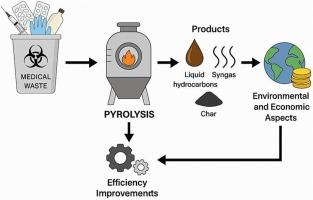Advancing sustainable medical waste management: The role of pyrolysis in resource recovery and environmental protection
IF 4.2
Q2 CHEMISTRY, MULTIDISCIPLINARY
引用次数: 0
Abstract
Medical waste presents significant challenges for solid waste management, demanding solutions that are both economically viable and environmentally sustainable. Pyrolysis has emerged as a promising thermochemical method for converting this waste into valuable energy and chemical products. However, practical implementation is often hindered by inefficiencies and concerns related to environmental compliance. Medical waste, which is typically bulky and potentially contaminated, primarily comprises polymer-based materials. These materials pose critical environmental and public health risks if not properly treated. Pyrolysis offers an environmentally friendly alternative by breaking down medical plastics in a low-oxygen environment to yield valuable products such as liquid hydrocarbons, syngas, and char. Recent advancements in catalytic pyrolysis and co-pyrolysis have enhanced product selectivity and yield, improving the commercial viability of the process. This review explores the mechanisms of polymer degradation, the application of pyrolysis for recycling medical waste, and the technological innovations that improve its efficiency. Additionally, the review addresses the environmental and economic aspects of pyrolysis, including strategies for managing feedstock variability, reducing energy consumption, and controlling emissions. Overall, the findings highlight pyrolysis as a promising and sustainable approach for managing medical waste, while also stressing the importance of further research into process optimization and the development of supportive regulatory policies.

推进医疗废物可持续管理:热解在资源回收和环境保护中的作用
医疗废物对固体废物管理提出了重大挑战,需要既具有经济可行性又具有环境可持续性的解决方案。热解已经成为一种很有前途的热化学方法,可以将这些废物转化为有价值的能源和化学产品。然而,实际执行常常受到效率低下和对环境遵从性的关注的阻碍。医疗废物通常体积庞大且可能受到污染,主要由聚合物材料构成。如果处理不当,这些材料将对环境和公众健康构成严重威胁。热解提供了一种环保的替代方案,通过在低氧环境中分解医用塑料,产生有价值的产品,如液态碳氢化合物、合成气和木炭。催化热解和共热解的最新进展提高了产品的选择性和产量,提高了该工艺的商业可行性。本文综述了聚合物降解的机理、热解在医疗废弃物回收中的应用以及提高其效率的技术创新。此外,该综述还讨论了热解的环境和经济方面的问题,包括管理原料可变性、降低能源消耗和控制排放的策略。总的来说,研究结果强调了热解是一种有前途的、可持续的医疗废物管理方法,同时也强调了进一步研究流程优化和制定支持性监管政策的重要性。
本文章由计算机程序翻译,如有差异,请以英文原文为准。
求助全文
约1分钟内获得全文
求助全文

 求助内容:
求助内容: 应助结果提醒方式:
应助结果提醒方式:


